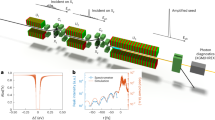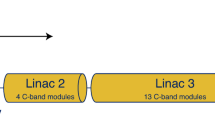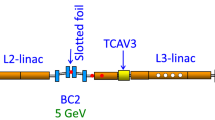Abstract
We present an experimental demonstration of a stable, low-loss, large X-ray cavity operating at 1.2 Å wavelength. The cavity consists of four separate high-reflectivity single crystal diamond Bragg mirrors arranged in a rectangular configuration with a round-trip distance of 14.2 m. Femtosecond X-ray pulses from an X-ray free-electron laser were coupled into the cavity via a transmission phase grating. We show that a stable mode can be maintained with the introduction of cavity focusing and measure round-trip efficiencies approaching 88%, or >96% when excluding grating and lens losses, close to the Bragg mirror theoretical performance limit. The direct observation of sustained stable X-ray circulation provides the most direct evidence to date that cavity-based X-ray free-electron lasers and other cavity-based hard X-ray systems are feasible.
This is a preview of subscription content, access via your institution
Access options
Access Nature and 54 other Nature Portfolio journals
Get Nature+, our best-value online-access subscription
$29.99 / 30 days
cancel any time
Subscribe to this journal
Receive 12 print issues and online access
$209.00 per year
only $17.42 per issue
Buy this article
- Purchase on Springer Link
- Instant access to full article PDF
Prices may be subject to local taxes which are calculated during checkout



Similar content being viewed by others
Data availability
The data presented in the figures have been uploaded to Zenodo. Source data are provided with this paper. Additional raw data that support the findings of this study are available from the corresponding author upon reasonable request.
References
Schawlow, A. L. & Townes, C. H. Infrared and optical masers. Phys. Rev. 112, 1940–1949 (1958).
Madey, J. M. J. Stimulated emission of bremsstrahlung in a periodic magnetic field. J. Appl. Phys. 42, 1906–1913 (1971).
Deacon, D. A. G. et al. First operation of a free-electron laser. Phys. Rev. Lett. 38, 892–894 (1977).
Litvinenko, V., Burnham, B., Madey, J. & Wu, Y. Dynamics of the Duke storage ring UV FEL. Nucl. Instrum. 358, 369–373 (1995).
Liss, K.-D. et al. Storage of X-ray photons in a crystal resonator. Nature 404, 371–373 (2000).
Shvyd'ko, Y. V. et al. X-ray interferometry with microelectronvolt resolution. Phys. Rev. Lett. 90, 013904 1–4 (2003).
Colella, R. & Luccio, A. Proposal for a free electron laser in the X-ray region. Opt. Commun. 50, 41–44 (1984).
Kondratenko, A. M. & Saldin, E. L. Generation of coherent radiation by a relativistic electron beam in am undulator. Part. Accel. 10, 207–216 (1980).
Bonifacio, R., Pellegrini, C. & Narducci, L. Collective instabilities and high-gain regime in a free electron laser. Opt. Commun. 50, 373–378 (1984).
Kim, K., Huang, Z. & Lindberg, R. Synchrotron Radiation and Free-Electron Lasers: Principles of Coherent X-Ray Generation (Cambridge Univ. Press, 2017).
Amann, J. et al. Demonstration of self-seeding in a hard-X-ray free-electron laser. Nat. Photon. 6, 693–698 (2012).
Inagaki, T. et al. Hard X-ray self-seeding set-up and results at SACLA. in Proc. 36th International Free Electron Laser Conference, TUC01 (eds Chrin, J. et al.) 603–608 (JACoW, 2014).
Lutman, A. A. et al. Demonstration of single-crystal self-seeded two-color X-ray free-electron lasers. Phys. Rev. Lett. 113, 254801 1–5 (2014).
Inoue, I. et al. Generation of narrow-band X-ray free-electron laser via reflection self-seeding. Nat. Photon. 13, 319–322 (2019).
Nam, I. et al. High-brightness self-seeded X-ray free-electron laser covering the 3.5 keV to 14.6 keV range. Nat. Photon. 15, 435–441 (2021).
Liu, S. et al. Cascaded hard X-ray self-seeded free-electron laser at MHz-repetition-rate. Preprint at Research Square, v1 https://doi.org/10.21203/rs.3.rs-2487501/v1 (2023).
Huang, Z. & Ruth, R. D. Fully coherent X-ray pulses from a regenerative-amplifier free-electron laser. Phys. Rev. Lett. 96, 144801 1–4 (2006).
Marcus, G. et al. Refractive guide switching a regenerative amplifier free-electron laser for high peak and average power hard X-rays. Phys. Rev. Lett. 125, 254801 1–6 (2020).
Marcus, G. et al. Regenerative amplification for a hard X-ray free-electron laser. in Proc. of the Free Electron Laser Conference, TUP032 Vol. 39 (eds Decking, W. et al.) 118–121 (JACoW, 2019).
Kim, K.-J. et al. A proposal for an X-ray free-electron laser oscillator with an energy-recovery linac. Phys. Rev. Lett. 100, 244802 1–4 (2008).
Halavanau, A. et al. Population inversion X-ray laser oscillator. Proc. Natl Acad. Sci. USA 117, 15511–15516 (2020).
Marcus, G. et al. Cavity-based free-electron laser research and development: a joint Argonne National Laboratory and SLAC National Laboratory collaboration. in Proc. of the Free Electron Laser Conference TUD04 (eds Decking, W. et al.) 282–287 (JACoW, 2019).
Rauer, P. et al. Cavity based X-ray free electron laser demonstrator at the European X-ray Free Electron Laser facility. Phys. Rev. Accel. Beams 26, 020701 1–14 (2023).
Shvyd'ko, Y., Stoupin, S., Blank, V. & Terentyev, S. Near-100% Bragg reflectivity of X-rays. Nat. Photon. 5, 539–542 (2011).
Sumiya, H., Harano, K. & Tamasaku, K. HPHT synthesis and crystalline quality of large high-quality (001) and (111) diamond crystals. Diam. Relat. Mater. 58, 221–225 (2015).
Chang, S.-L. et al. Crystal cavity resonance for hard X-rays: a diffraction experiment. Phys. Rev. B 74, 134111 1–7 (2006).
Chollet, M. et al. The X-ray Pump-Probe instrument at the Linac Coherent Light Source. J. Synchrotron. Rad. 22, 503–507 (2015).
Zhu, D. et al. Performance of a beam-multiplexing diamond crystal monochromator at the Linac Coherent Light Source. Rev. Sci. Instrum. 85, 063106 1–7 (2014).
Stoupin, S. et al. All-diamond optical assemblies for a beam-multiplexing X-ray monochromator at the Linac Coherent Light Source. J. Appl. Crystallogr. 47, 1329–1336 (2014).
Li, K. et al. Wavefront preserving and high efficiency diamond grating beam splitter for X-ray free electron laser. Opt. Express 28, 10939–10950 (2020).
Snigirev, A., Kohn, V., Snigireva, I. & Lengeler, B. A compound refractive lens for focusing high-energy X-rays. Nature 384, 49–51 (1996).
Authier, A. Dynamical Theory of X-ray Diffraction (Oxford Univ. Press, 2001).
Scharlemann, E. T., Sessler, A. M. & Wurtele, J. S. Optical guiding in a free-electron laser. Phys. Rev. Lett. 54, 1925–1928 (1985).
Blachman, N. M. & Courant, E. D. The dynamics of synchrotron with straight sections. Rev. Sci. Instrum. 20, 596–601 (1949).
Qi, P. & Shvyd’ko, Y. Signatures of misalignment in X-ray cavities of cavity-based X-ray free-electron lasers. Phys. Rev. Accel. Beams 25, 050701 1–20 (2022).
Tiwari, G. & Lindberg, R. R. Misalignment effects on the performance and stability of X-ray free-electron laser oscillator. Phys. Rev. Accel. Beams 25, 090702 1–22 (2022).
Lindberg, R. R., Kim, K.-J., Cai, Y., Ding, Y. & Huang, Z. Transverse gradient undulators for a storage ring x-ray FEL oscillator. in Proc. of the Free Electron Laser Conference THOBNO02 (eds Scholl, C. & Schaa, V.) 740–748 (JACoW, 2013).
Yamaji, T. et al. An experiment of X-ray photon-photon elastic scattering with a Laue-case beam collider. Phys. Lett. B 763, 454–457 (2016).
Adams, B. W. et al. X-ray quantum optics. J. Mod. Opt. 60, 2–21 (2013).
Pradhan, P. et al. Small Bragg-plane slope errors revealed in synthetic diamond crystals. J. Synchrotron Rad. 27, 1553–1563 (2020).
Tamasaku, K., Ueda, T., Miwa, D. & Ishikawa, T. Goniometric and topographic characterization of synthetic IIa diamonds. J. Phys. D: Appl. Phys. 38, A61–A66 (2005).
Halavanau, A. et al. Experimental setup for high-resolution characterization of crystal optics for coherent X-ray beam applications. J. Appl. Crystallogr. 56, 155–159 (2023).
Acknowledgements
We are indebted to K.-J. Kim, Y. Shvyd’ko, R. Lindberg, D. Shu and H. Sumiya for insightful discussions. Diamond mirror characterization was performed at RIKEN SPring-8 (proposal numbers 20190013 and 20200085) and at the Stanford Synchrotron Radiation Light Source. Use of the Linac Coherent Light Source, SLAC National Accelerator Laboratory, was supported by the US Department of Energy, Office of Science, Office of Basic Energy Sciences under Contract No. DE-AC02-76SF00515. This research was also supported by the Department of Energy Laboratory Directed Research and Development programme at SLAC.
Author information
Authors and Affiliations
Contributions
J.M., G.M., Z.H. and D.Z. conceived the experiment. R.M., R.R., A.H., K.L., T.O., A.S., T.S., Y.S., K.T., G.M. and D.Z. carried out the experiment. R.M., R.R., A.H., K.L., J.M., T.O., A.S., T.S. and K.T. prepared X-ray cavity optics. R.M., R.R., A.H., J.K., T.S., Y.S., G.M. and D.Z. performed the data analysis. R.M., R.R., A.H., G.M., Z.H. and D.Z. wrote the manuscript with input from all co-authors.
Corresponding authors
Ethics declarations
Competing interests
The authors declare no competing interests.
Peer review
Peer review information
Nature Photonics thanks Enrico Allaria, Heung-Sik Kang, Jörg Rossbach, Timur Shaftan and the other, anonymous, reviewer(s) for their contribution to the peer review of this work.
Additional information
Publisher’s note Springer Nature remains neutral with regard to jurisdictional claims in published maps and institutional affiliations.
Supplementary information
Supplementary Information
Supplementary Figs. 1–4, Table 1, and Discussion.
Source data
Source Data Fig. 2
Ring-down traces and cavity efficiency datapoints.
Source Data Fig. 3
Fitted beam size and trajectory datapoints.
Rights and permissions
Springer Nature or its licensor (e.g. a society or other partner) holds exclusive rights to this article under a publishing agreement with the author(s) or other rightsholder(s); author self-archiving of the accepted manuscript version of this article is solely governed by the terms of such publishing agreement and applicable law.
About this article
Cite this article
Margraf, R., Robles, R., Halavanau, A. et al. Low-loss stable storage of 1.2 Å X-ray pulses in a 14 m Bragg cavity. Nat. Photon. 17, 878–882 (2023). https://doi.org/10.1038/s41566-023-01267-0
Received:
Accepted:
Published:
Issue Date:
DOI: https://doi.org/10.1038/s41566-023-01267-0
This article is cited by
-
Stimulated X-ray emission spectroscopy
Photosynthesis Research (2024)
-
A step towards cavity-based X-ray free electron lasers
Nature Photonics (2023)



